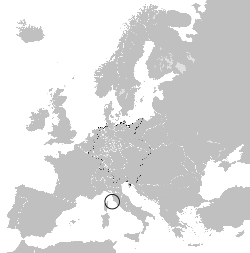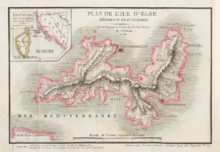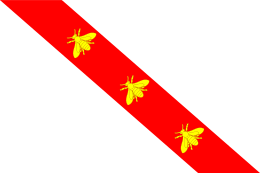Principality of Elba
| Principality of Elba Principato d'Elba | |||||||||
|---|---|---|---|---|---|---|---|---|---|
| 1814–1815 | |||||||||
 Location of the Principality of Elba within Europe | |||||||||
| Capital | Portoferraio | ||||||||
| Common languages | Italian | ||||||||
| Religion | Roman Catholic | ||||||||
| Demonym | Elban | ||||||||
| Government | Non-hereditary monarchy | ||||||||
| Sovereign of Elba | |||||||||
• 1814-1815 | Napoleon Bonaparte | ||||||||
| Governor of Elba | |||||||||
• 1814-1815 | Antoine Drouot | ||||||||
| Historical era | Napoleonic Wars | ||||||||
| April 13 1814 | |||||||||
| February 26, 1815 | |||||||||
| June 9 1815 | |||||||||
| Area | |||||||||
| 1814 | 224 km2 (86 sq mi) | ||||||||
| Population | |||||||||
• 1814 | 12000 | ||||||||
| Currency | French Franc | ||||||||
| |||||||||
The Principality of Elba (Italian: Principato d'Elba) was a non-hereditary monarchy established by the Treaty of Fontainebleau of 11 April 1814. It lasted less than a year, and its only head was Napoleon.
Formation
Sovereignty over the island, which until then had been part of the French département of Méditerranée, was given to Napoleon I of France after his abdication following the War of the Sixth Coalition. Article 3 of the treaty stipulated that Elba was to be "an independent principality possessed by him in complete sovereignty and as personal property".[1] His rule was to persist until his death, at which point control of the Principality would return to Tuscany. The former emperor was also granted a stipend of two million francs per year to be paid by France.
Napoleon's government
Upon Napoleon's landing on the island, the Mayor of Portoferraio, Pietro Traditi, presented the keys to the city to the Emperor. After which, Napoleon begun work as sovereign of the island, starting by writing a small, three-paged constitution, outlining five government departments: the departments of civil administration, the communes, the domains reserved for the emperor, the imperial palace, and the army. General Henri Bertrand was appointed grand marshal of the palace, a post he held during Napoleon's reign in France, and was in charge of the civil administration. General Drouot was appointed Governor of the island and charged with military matters, Giuseppe Balbiani was named Intendant General of police, and Guillaume-Joseph Roux was made treasurer. Napoleon created a conseil souverain (Sovereign's Council), seating on the council was twelve members: four Frenchmen and eight Elbans. Five councillors were made members of the court of first instance, with Balbiani as President. The remaining members of the Sovereign's Council were placed on the court of appeal, without any presiding head. However, despite the power held by the council, most government power was vested in the four French ministers brought from the former regime, and Napoleon himself who took an extremely active role in governing the principality.
Military
As allowed by the Treaty of Fontainebleau, Napoleon brought 870 men to the island with him from France. The army was made up of 566 from the elite Garde impériale (both infantry and cavalry) and the remaining 300 were from a small battalion of grenadiers. The army was under the supervision of General Drouot and commanded by General Cambronne and the staff headquarters. The Navy consisted of 66 men and one ship: the double-masted, 18-gunned brig, Inconstant. A small flotilla of two other sloops also accompanied Inconstant. The fleet was first commanded by Lieutenant Taillade; however, after nearly losing Inconstant in a storm, Taillade was replaced by lieutenant J. Chautard, who would later ferry Napoleon back from Elba in 1815. Paoli Filidoro was appointed Captain of the Gendarmerie and operated under Giuseppe Balbiani as Intendant General. The combined armed forces by 1815 on Elba numbered about 1,000 men, costing over half of the treasury to pay, equip, and feed.
Dissolution
On 26 February, after a rule of 9 months, Napoleon escaped from Elba and landed in southern France to lead the French again, beginning the War of the Seventh Coalition. After his defeat at the Battle of Waterloo, Napoleon was transported by Britain to the Island of St. Helena where he remained a prisoner until his death. At the Congress of Vienna, sovereignty of the island was returned to the Grand Duchy of Tuscany.

References
- Gruyer, Paul (1908). Napoleon, King of Elba. London: William Heinemann.

